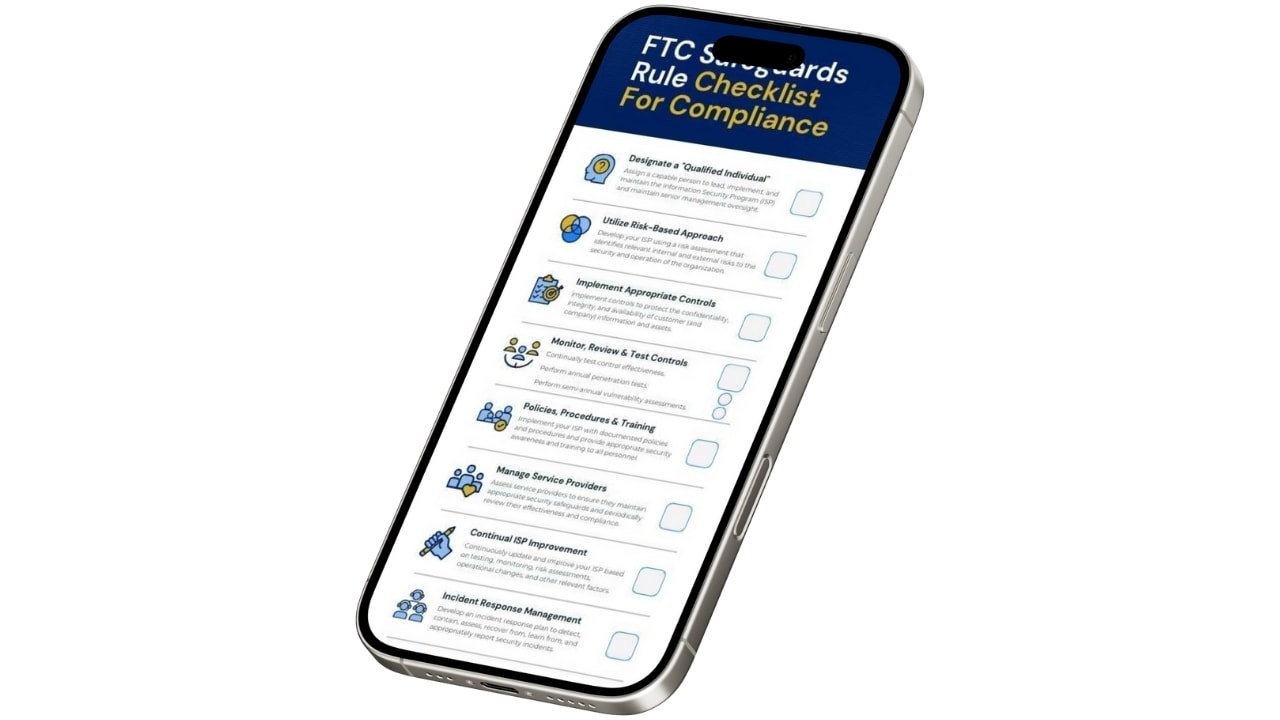FTC Safeguards Rule Checklist for Compliance Series: Information Security Policies, Procedures & Training
Apr 03, 2025
Navigating the maze of compliance can feel like wandering through a haunted house—you're never quite sure when something will pop out and scare the compliance out of you. Fortunately, staying on the right side of the FTC Safeguards Rule doesn't have to be a horror show. This installment of our FTC Safeguards Rule Checklist for Compliance series focuses on policies, procedures, and training—the foundation for keeping your information security program (and your peace of mind) intact.
📋 Follow Along with the FTC Safeguards Rule Compliance Checklist

This article is part of our ongoing series designed to help you tackle each core requirement of the Federal Trade Commission's Safeguards Rule, one step at a time. To make life easier, we've created a visual checklist and infographic that outlines all the key controls, giving you a practical way to track your progress.
👉 Download the FTC Safeguards Rule Checklist Infographic to follow along as you read.
What is the FTC Safeguards Rule?
The FTC Safeguards Rule, established under the Gramm-Leach-Bliley Act (GLBA), requires financial institutions to put in place measures that safeguard sensitive customer information. Originally introduced in 2003 and significantly updated in 2021, with compliance deadlines as recent as June 2023, the rule has stepped up its game to include more structured cybersecurity measures. The goal? Prevent unauthorized access and data breaches by implementing administrative, technical, and physical safeguards, thereby enhancing the organization's security posture.
Who Must Comply with the FTC Safeguards Rule for Financial Institutions?
Contrary to popular belief, you don’t have to be a bank to fall under the Safeguards Rule. The term “financial institution” covers a wide array of businesses that handle financial activities, including those engaged in such financial activities. This includes:
-
Tax preparers and CPA firms
-
Mortgage lenders and brokers
-
Auto dealerships offering financing
-
Payday lenders
-
Credit repair companies
-
Investment advisors not regulated by the SEC
-
Personal property appraisers
If your business collects, stores, or transmits customer financial data, chances are you’re covered—and ignoring the rule could mean hefty fines and a very awkward conversation with regulators.
FTC Safeguards Rule Checklist – Core Requirements
To comply with the FTC Safeguards Rule, institutions must:
-
Appoint a Qualified Individual to manage the information security program (16 CFR § 314.4(a)). This person serves as the senior authority responsible for overseeing compliance and regularly reporting to the Board of Directors.
-
Create and sustain a WISP (Written Information Security Plan) and ISP (Information Security Program) by adopting a “risk-based approach” informed by ongoing risk assessments (16 CFR § 314.4(b)).
-
Implement safeguards to control identified risks (16 CFR § 314.4(c))
-
Regularly monitor and test controls (16 CFR § 314.4(d))
-
Train personnel and implement security policies and procedures (16 CFR § 314.4(e))
-
Oversee service providers and vendors (16 CFR § 314.4(f))
-
Update the ISP based on results and changes (16 CFR § 314.4(g))
-
Create a written incident response plan (16 CFR § 314.4(h))
-
Deliver annual reports to senior leadership or the board (16 CFR § 314.4(i))
Developing an Information Security Program
Creating a robust information security program is like building a fortress around your organization’s data. This policy is the blueprint for safeguarding taxpayer data, detecting unauthorized access, and responding to data breaches. Tailored to your organization’s unique needs, it should outline risk assessment and management procedures, as well as incident response and disaster recovery plans. Further, it must be fully documented in the form of a WISP - Written Information Security Policy.
The FTC Safeguards Rule specifies that covered financial institutions must develop, implement, appropriately maintain, and continually improve an information security program. This program must include administrative, technical, and physical safeguards to protect customer information. This means your policy should cover everything from multi-factor authentication for accessing customer information to encryption and secure disposal methods for maintaining customer information.
In today’s rapidly evolving threat landscape, it’s crucial to consider emerging threats and vulnerabilities. Regularly review and update your information security policy to ensure it remains effective in protecting your organization’s security posture by applying appropriate safeguards. Remember, a well-crafted policy is not just a compliance requirement—it’s your first line of defense against data breaches.
Information Security Program Essentials - Implementing Security Policies, Procedures, and Employee Training

Effectively implementing policies, procedures, and training is a cornerstone of compliance with the FTC Safeguards Rule. This includes establishing access controls to manage user permissions and mitigate risks associated with insider threats. Under 16 CFR § 314.4(e), organizations are required to ensure that personnel are not only informed about but actively engaged in maintaining information security. This section will break down the critical elements of implementing policies, procedures, and training to ensure your compliance efforts are up to par.
Implementing Information Security Policies and Procedures (16 CFR § 314.4(e))
The Federal Trade Commission's Safeguards Rule requires covered financial institutions to have a fully documented Written Information Security Program (WISP). A comprehensive WISP should include relevant information security policies and procedures tailored to your organization’s specific risks and operational needs. These documents need to be formally approved by leadership, reviewed at least annually, and distributed to all relevant personnel to ensure awareness and adherence.
A robust WISP typically includes some of the the following information security policies:
-
Acceptable Use Policy: Outlines how employees can use company resources.
-
Data Classification and Handling Policy: Defines how nonpublic personal information and other sensitive data should be managed and stored to securely maintain customer information.
-
Cryptography Management Policy: Identifies how to encrypt customer information and securely transmit customer information. Access Control Policy: Regulates who can access specific data and systems.
-
Incident Response Policy: Details how to respond to security events and security incidents.
-
Mobile Device Management Policy: Governs the use of mobile devices within the organization.
-
Third-Party Risk Management Policy: Manages risks associated with vendor relationships and service providers.
-
Identity and Access Management Policy: Identifies how to restrict access to sensitive data to authorized users (those with a legitimate business need) and how to implement multi factor authentication.
It’s crucial that your security policy aligns with widely accepted standards, such as ISO 27001, to maintain a strong security posture and reduce the risk of compliance issues. Regular updates are necessary to reflect evolving threats and regulatory changes.
Key takeaways:
-
Develop a comprehensive WISP that covers essential policies.
-
Obtain leadership approval and conduct annual reviews.
-
Distribute policies to all personnel to ensure awareness and compliance.
🚀 How Input Output Can Help: We specialize in crafting tailored WISP solutions, including developing necessary policies and ensuring they align with FTC, IRS Publication 4557, ISO 27001, PCI, and other standards. Let us help you build a compliant and resilient information security framework. You can even utilize our complete FTC Safeguards Rule WISP to make managing your company's compliance even easier.
Information System Security Training and Awareness

Training your employees is not a one-and-done affair. To maintain compliance, training must be consistent, comprehensive, and tailored to the roles within your organization. Security and awareness training involves educating employees on recognizing and responding to potential threats, as well as understanding the policies that govern safe data practices to protect customer information.
There are several types of training to consider, including:
-
Automated Training Modules: These online sessions can be assigned based on job role and risk exposure, allowing for scalable and repeatable education.
-
Simulated Phishing Exercises: Test how employees respond to phishing attempts, helping to identify areas where additional training is needed.
-
Posters and Email Notifications: Reinforce key security practices through visual aids and regular updates that keep information system security top of mind.
The goal is to protect employees against common threats, including phishing, smishing (SMS phishing), vishing (voice phishing), quishing (QR code phishing), and social engineering attacks. Effective training programs should incorporate real-world scenarios to help employees recognize and avoid these threats.
Best practices for training:
-
Conduct regular, role-specific training sessions.
-
Include automated, interactive exercises and phishing simulations.
-
Reinforce training with visual aids and ongoing notifications.
-
Regularly update training content to reflect emerging threats.
📚 Stay Compliant with Input Output: Our ClickSafe Academy offers tailored training programs designed to educate your team on the latest threats, including phishing, smishing, vishing, quishing, and social engineering. Plus, our iO™ SecCom Monthly newsletter keeps your organization informed of evolving risks.
Ongoing Training and Updates
Information security is an evolving landscape. To stay compliant, it’s essential to provide ongoing training that addresses both foundational knowledge and emerging threats. Ongoing training should not be limited to generic content but should be tailored to the organization’s specific risks and industry requirements. Regular updates help ensure that employees remain aware of both foundational principles and the latest threats, including phishing, smishing, vishing, quishing, and social engineering attacks.
There are two primary types of training to consider:
-
General Security Training: This foundational training covers basic cybersecurity principles, including password management, identifying phishing emails, and safe internet practices. It should be relevant to all employees, regardless of role.
-
Organization and Industry-Specific Training: Tailored to the unique threats and compliance requirements of your industry, this training focuses on protecting industry-specific data, such as financial information for banking institutions or personal health data for healthcare providers.
To maximize effectiveness, ongoing training should also address emerging threats. This means integrating content based on new attack vectors, recent breaches in similar industries, and evolving tactics used by cybercriminals. Employees must be made aware of threats specific to their roles and responsibilities, as well as broader organizational risks.
Best practices for ongoing training:
-
Conduct role-specific training and industry-focused sessions.
-
Include content on both foundational and emerging threats.
-
Regularly update training materials to reflect the latest risk landscape.
-
Utilize interactive and practical exercises to reinforce learning.
🔄 Input Output’s Support: Our ClickSafe Academy not only provides comprehensive foundational training but also delivers ongoing updates tailored to your industry. We ensure your employees are equipped to face both established and emerging threats, keeping your organization resilient and compliant.
Maintaining Awareness of Security Threats

Staying on top of the ever-changing threat landscape is one of the most significant challenges for any organization. This includes implementing measures to detect unauthorized access and prevent potential data breaches. It’s not enough to conduct training once and call it a day—maintaining awareness requires a proactive approach, continuous updates, and effective communication throughout the company. The goal is to ensure that all personnel, from leadership to entry-level employees, are informed about emerging and current threats.
One effective way to maintain awareness is to leverage threat intelligence feeds. Subscribing to reputable sources keeps your security team informed about the latest vulnerabilities, attack vectors, and threat actor activities. Additionally, participating in industry forums and professional networks can provide valuable insights from peers who are dealing with similar challenges.
Timely communication is also crucial. Organizations should establish channels to quickly disseminate information about emerging threats. This can include:
-
Regular newsletters that summarize current threats and best practices.
-
Email alerts that highlight urgent or high-risk vulnerabilities.
-
Posters and infographics placed in common areas to remind staff of ongoing threats.
-
Interactive training modules triggered by specific threat scenarios.
Fostering a culture of continuous learning ensures that employees remain vigilant and proactive. Encourage feedback from staff on new threats they encounter and share lessons learned across teams. Integrating threat awareness into daily routines will help reduce complacency and foster a more security-conscious mindset.
💡 Input Output’s Advantage: Beyond our ClickSafe Academy, which offers ongoing training and threat updates, we also provide a dedicated newsletter that delivers timely information on current threats and compliance updates. This helps organizations stay compliant with the FTC Safeguards Rule and ensures that your team remains prepared to face emerging challenges.
How Input Output Can Help
At Input Output, we offer comprehensive solutions to meet these requirements and more. Whether you need a full WISP, policy templates, gap assessments, or security training, we’ve got you covered. Our services also include managing incidents like a data breach to ensure your organization remains compliant. Plus, our phishing and social engineering exercises keep your team sharp and prepared.
Don’t go it alone—compliance is tough enough without flying solo. Schedule a consultation today to see how we can make your life easier (and your compliance foolproof).
Conclusion
Meeting the FTC Safeguards Rule requirements and other federal regulations doesn't have to feel like preparing for a tax audit. With the right policies, procedures, and training, you can transform compliance from a daunting task into a routine part of your business strategy. Remember, Input Output is here to help every step of the way. So, relax, breathe, and let’s tackle compliance together.
STAY INFORMED
Subscribe now to receive the latest expert insights on cybersecurity, compliance, and business management delivered straight to your inbox.
We hate SPAM. We will never sell your information, for any reason.


